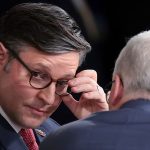Alone in a windowless room in the Kremlin, Vladimir Putin last week presided over Russia’s nuclear forces as they rehearsed a massive retaliatory strike from air, land, and sea.
Simulating a radioactive mushroom cloud that could render much of the planet uninhabitable served as a stark reminder of the nuclear deterrent the Russian president still has at his disposal.
The posturing, experts say, is Putin’s way of keeping nuclear tensions at a simmer even as he dialled down threats that had alarmed allies and foes alike about the war in Ukraine turning into an atomic conflagration.
The Russian leader first stoked fears he could carry out a limited nuclear strike in Ukraine in a speech on the eve of the 2022 full-scale invasion. He then vowed to “use all the means at our disposal” to defend Russia’s conquests when he annexed four Ukrainian regions six months later.
Those threats prompted the US, UK and France to vow retaliation with conventional weapons, according to current and former officials. Chinese leader Xi Jinping, who has otherwise given tacit backing to Russia’s war in Ukraine, has also personally warned Putin against using nuclear weapons, including at a face-to-face meeting in March, officials said.
Putin admitted last autumn it would make no “political or military sense” to use tactical nuclear weapons and largely stopped talking about his atomic arsenal.

“It became clear that nobody likes the idea of nuclear weapons being involved in this war, and there was strong opposition from many countries, including those close to Putin,” said Pavel Podvig, a senior researcher at the UN Institute for Disarmament Research in Geneva.
Instead, in recent months, Russia has explored other ways to use its atomic arsenal as a deterrent against western support for Ukraine. While these measures fall short of outright threats, they attempt to show Russia’s determination in Ukraine, and the broader cost of standing in its way.
Last month, the Russian parliament de-ratified the Comprehensive Nuclear Test Ban Treaty. The move could pave the way for atomic testing to resume for the first time since the Soviet Union collapsed, though Russia has said it will only do so in response to possible US tests.
Moscow also carried out a “final test” on a new missile Putin says has potentially unlimited range; deployed tactical nuclear weapons to neighbouring Belarus; and suspended its participation in the New Start treaty, the last major arms control deal still in force with the US.
“There was an understanding that Russia won’t gain any friends by putting emphasis on its nuclear weapons,” said Podvig. “So the de-ratification of CTBT was a kind of compromise, if you will, between those who want a strong stick and those who realise it would be counterproductive.”
Western countries have so far reacted with restraint to Russia’s tests of its advanced new weapons systems, which have been plagued by delays and failed launches.
“Some of these are truly exotic systems that don’t particularly have any real military value,” Podvig said. “They allow Putin to say, we have a response and this is something that nobody else has. So it makes him happy, which in today’s Russia is no small thing.”
In Moscow, the measures taken in regards to the nuclear arsenal were portrayed as a sign of Russia successfully containing the west. “Less talk, more action,” said Dmitry Trenin, a prominent foreign policy academic who favours nuclear sabre-rattling to “bring back fear” in western capitals.
Putin’s moves showed he had realised that Russia’s attempts to deter the west from supporting Ukraine “need significant strengthening”, Trenin said. “This is an important step towards adapting our peacetime containment policy to the conditions of a real war, an indirect one for now.” In winning the war in Ukraine, Trenin said, “Russia will look at all the resources it has without exception, including heightened nuclear containment.”

Hardliners in Moscow meanwhile are worrying that Russia risks looking weak in the absence of a credible atomic threat and have started advocating for pre-emptive nuclear strikes.
In June, Sergei Karaganov, another influential academic, wrote an article urging Russia “to hit a bunch of targets in a number of countries in order to bring those who have lost their mind to reason” and end western support for Ukraine. Last month, Karaganov advocated for Putin to revise Russia’s nuclear doctrine “to lower the nuclear threshold and go firmly, but quite quickly up the escalation ladder to contain and sober up our partners”.
Putin, who said he was familiar with Karaganov’s proposals, has argued there was no need to alter the doctrine, listing the successful test of his “invincible” ballistic missiles and the de-ratification of the CTBT.
But within Russia’s propaganda machine, some nuclear hawks are becoming louder and more unhinged.
Dmitry Medvedev, who served as president and prime minister of Russia, mused on X, formerly Twitter, that the “Apocalypse revelations are drawing nearer” as western countries supplied Ukraine with more advanced weapons. Margarita Simonyan, editor of state news network RT, proposed detonating a thermonuclear weapon in the atmosphere hundreds of kilometres above Siberia to take out telecommunications and send a “painful” message to the west. Siberian officials demanded an apology.
Western analysts warn that Putin’s toned-down rhetoric does not mean the nuclear threat has disappeared.
“They have realised they need to go beyond rhetoric to keep up the spectre of nuclear escalation risk over this conflict,” said Hanna Notte, director of the Eurasia non-proliferation programme at the James Martin Center for Nonproliferation Studies.
“It’s broad signalling that Russia is dead serious in this conflict and that this stand-off with the west over Ukraine elevates nuclear risks in Europe.”
Read the full article here



